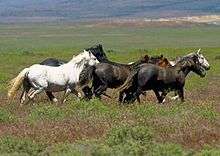Pangaré


Pangaré is a coat trait found in some horses that features pale hair around the eyes and muzzle and underside of the body. These pale areas can extend up to the flanks, throat and chest, behind the elbows, in front of the stifle, and up the buttock.[1] Animals with the pangaré trait are sometimes called "mealy" or "light-pointed". The color of these lighter areas depends on the underlying color and ranges from off-white to light tan.[2] This type of coloration is most often found in primitive breeds like the Fjord horse, Exmoor Pony, American Belgian Draft, and Haflinger. Wild equids like the Przewalski's Horse, Onager, African Wild Ass, Kiang as well as the domestic Donkey exhibit pangaré as a rule.[3] Pangaré is thought to be a type of protective countershading.
Horse foals are often born with "foal pangaré" or light points, especially over black haired areas, which they lose when they shed their foal coats.
Dr. Phillip Sponenberg suggested that the "seal brown" coat color was caused by the action of pangaré on a black coat. However, seal brown horses have since tested negative for the recessive black genotype.
Chestnut horses with pangaré are sometimes called "Belgian sorrels".
References
- ↑ Marcia Stacy. "Pangare (mealy)". Icelandic Horse Colors. Retrieved 2008-06-26.
- ↑ "Mealy/Pangare (Other Modifiers)". Equine Color. Nov 2003. Archived from the original on 2008-05-17. Retrieved 2008-06-26.
- ↑ Leah Patton. "Pangare - Extensive "mealy points" on Mules". The Mule Info Page. Archived from the original on 2009-10-22. Retrieved 2008-06-26.
